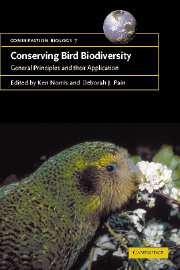Book contents
- Frontmatter
- Contents
- List of contributors
- Preface
- 1 Biodiversity – evolution, species, genes
- 2 Why conserve bird diversity?
- 3 Mapping and monitoring bird populations: their conservation uses
- 4 Priority-setting in species conservation
- 5 Selecting sites for conservation
- 6 Critically endangered bird populations and their management
- 7 Diagnosing causes of population declines and selecting remedial actions
- 8 Outside the reserve: pandemic threats to bird biodiversity
- 9 Predicting the impact of environmental change
- 10 Fragmentation, habitat loss and landscape management
- 11 The interface between research, education and training
- 12 Conservation policies and programmes affecting birds
- References
- Index
5 - Selecting sites for conservation
Published online by Cambridge University Press: 10 December 2009
- Frontmatter
- Contents
- List of contributors
- Preface
- 1 Biodiversity – evolution, species, genes
- 2 Why conserve bird diversity?
- 3 Mapping and monitoring bird populations: their conservation uses
- 4 Priority-setting in species conservation
- 5 Selecting sites for conservation
- 6 Critically endangered bird populations and their management
- 7 Diagnosing causes of population declines and selecting remedial actions
- 8 Outside the reserve: pandemic threats to bird biodiversity
- 9 Predicting the impact of environmental change
- 10 Fragmentation, habitat loss and landscape management
- 11 The interface between research, education and training
- 12 Conservation policies and programmes affecting birds
- References
- Index
Summary
INTRODUCTION
Over the past decade, the issue of identifying where we might best focus limited conservation resources has received enormous attention from conservation practitioners and academics alike. The result has been an impressive raft of real-world priority schemes (see Box 5.1, p. 77), the development of powerful techniques for systematic site selection, and the collation of several substantial data sets to which these tools can be applied. This chapter aims to review these developments, examining how priorities are currently set, and exploring how prioritisation might be further improved in future. The focus throughout is on identifying priority areas for conservation (rather than priority species, as in Chapter 4)– with a particular emphasis on the identification of the most appropriate sites for reservation (rather than on the wider landscape issues addressed in Chapters 8 and 10). For an excellent account of how the selection of priority sites fits into a broader framework of conservation planning, including the design, management and subsequent monitoring of conservation areas, see the review by Margules & Pressey (2000).
I begin by considering why prioritisation is necessary, before outlining the importance of establishing a priori the goals and scale of any priority-setting exercise. The bulk of the chapter then sets out a series of biological and human-linked concerns that need to be addressed in selecting priority sites, and examines how recent theoretical tools and real-world priority schemes tackle these concerns.
- Type
- Chapter
- Information
- Conserving Bird BiodiversityGeneral Principles and their Application, pp. 74 - 104Publisher: Cambridge University PressPrint publication year: 2002
- 9
- Cited by

